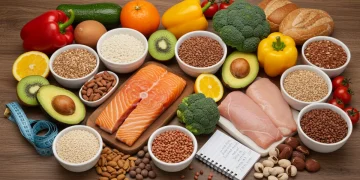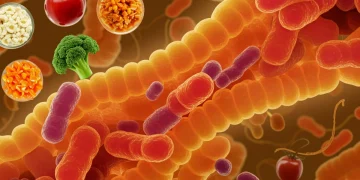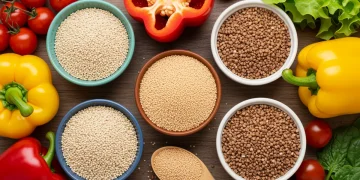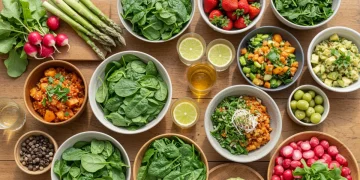2025 Fermented Foods Guide: Boost Gut Health by 25%

Fermented foods are poised to be a cornerstone of dietary health in 2025, offering a natural and effective way to enhance gut microbiome diversity, with simple homemade recipes for kimchi, sauerkraut, and kefir contributing significantly to overall well-being.
Welcome to The 2025 Guide to Fermented Foods: 4 Simple Homemade Recipes for Kimchi, Sauerkraut, and Kefir to Boost Gut Microbiome Diversity by 25%. Have you ever considered the profound impact your gut health has on your overall well-being? It’s more significant than many realize, influencing everything from mood to immunity. This guide aims to demystify the world of fermented foods, offering practical steps to integrate these powerful allies into your daily diet.
The Gut Microbiome: Your Inner Ecosystem
Understanding the gut microbiome is the first step towards appreciating the power of fermented foods. This intricate ecosystem within your digestive tract is home to trillions of microorganisms, including bacteria, viruses, fungi, and other microbes. Far from being mere passengers, these organisms play a critical role in numerous bodily functions, influencing digestion, nutrient absorption, immune system regulation, and even mental health. A diverse and balanced microbiome is often associated with better health outcomes, while an imbalance, known as dysbiosis, can contribute to various health issues.
The concept of the gut as a ‘second brain’ isn’t just a catchy phrase; it reflects the extensive communication network between the gut and the brain, known as the gut-brain axis. This connection means that the health of your gut can directly impact your mood, cognitive function, and susceptibility to stress. Maintaining a robust and diverse microbial community is therefore paramount for holistic health. Diet plays a pivotal role in shaping this community, and this is where fermented foods shine.
What is Microbiome Diversity and Why Does it Matter?
Microbiome diversity refers to the variety of different microbial species present in your gut. Just like a diverse ecosystem in nature is more resilient and adaptable, a diverse gut microbiome is generally considered healthier and more capable of performing its various functions effectively. A wide range of species means a wider array of metabolic capabilities, which can lead to better digestion of different food components, production of a broader spectrum of beneficial compounds (like short-chain fatty acids), and enhanced protection against pathogens.
- Enhanced Nutrient Absorption: Diverse microbes help break down complex carbohydrates and synthesize vitamins.
- Stronger Immune System: A balanced microbiome trains the immune system to distinguish between friend and foe.
- Improved Mental Health: Gut microbes produce neurotransmitters and influence brain chemistry.
- Reduced Inflammation: Certain bacteria can produce anti-inflammatory compounds, reducing systemic inflammation.
Increasing the diversity of your gut microbiome is a key strategy for improving overall health and resilience. Fermented foods, rich in live beneficial bacteria, offer a direct and delicious way to introduce new microbial strains into your digestive system, contributing to this essential diversity. By regularly consuming these foods, you actively cultivate a more robust and varied inner ecosystem, setting the stage for improved health in 2025 and beyond.
The Science Behind Fermentation and Gut Health
Fermentation, an ancient preservation technique, is experiencing a modern resurgence due to its profound health benefits, particularly for gut health. This process involves microorganisms—such as bacteria, yeasts, and molds—converting carbohydrates into alcohol, gases, or organic acids. This transformation not only preserves food but also enhances its nutritional value and creates new beneficial compounds, including probiotics.
When you consume fermented foods, you’re not just eating food; you’re ingesting live cultures that can colonize your gut and contribute to your existing microbiome. These new microbial residents, often referred to as probiotics, can help to rebalance an imbalanced gut, bolster beneficial bacterial populations, and even displace harmful pathogens. The organic acids produced during fermentation, like lactic acid, also contribute to a lower pH in the gut, creating an environment less hospitable to undesirable bacteria.
How Probiotics from Fermented Foods Work
Probiotics are live microorganisms that, when administered in adequate amounts, confer a health benefit on the host. In fermented foods, these probiotics are naturally occurring and come in various strains, each offering unique benefits. For instance, some strains might specialize in aiding digestion, while others could focus on immune modulation or even mood regulation. The beauty of fermented foods lies in their natural diversity of these beneficial microbes.
- Competitive Exclusion: Probiotics compete with harmful bacteria for resources and attachment sites in the gut.
- Production of Antimicrobial Compounds: Some strains produce substances that inhibit the growth of pathogens.
- Enhancement of Gut Barrier Function: They can help strengthen the intestinal lining, reducing ‘leaky gut’ syndrome.
- Modulation of Immune Responses: Probiotics interact with immune cells in the gut, influencing systemic immunity.
Beyond introducing new bacteria, fermented foods also make nutrients more bioavailable. The fermentation process can break down complex compounds that are otherwise difficult for the human digestive system to process, such as lactose in dairy or phytic acid in grains. This means you might absorb more vitamins and minerals from fermented versions of foods than from their unfermented counterparts. This dual action—introducing beneficial microbes and enhancing nutrient availability—makes fermented foods an incredibly powerful tool for gut health.
Homemade Kimchi: A Spicy Probiotic Powerhouse
Kimchi, a staple of Korean cuisine, is far more than just a side dish; it’s a vibrant, spicy, and incredibly beneficial fermented vegetable preparation. Typically made from napa cabbage and various seasonings like gochugaru (Korean chili powder), garlic, ginger, and scallions, kimchi undergoes lactic acid fermentation, resulting in a rich source of probiotics and a complex flavor profile that ranges from tangy to umami, with a satisfying kick. Making kimchi at home allows you to control the ingredients and spice level, ensuring a fresh and potent probiotic boost.
The fermentation process transforms the humble cabbage into a nutritional powerhouse. The lactic acid bacteria, primarily from the Lactobacillus genus, not only preserve the vegetables but also produce beneficial compounds and increase the bioavailability of nutrients. Regular consumption of kimchi has been linked to improved digestion, enhanced immune function, and even potential anti-inflammatory effects. It’s a delicious way to diversify your gut microbiome.
Simple Homemade Kimchi Recipe
Creating your own kimchi is a rewarding process that doesn’t require specialized equipment. This recipe focuses on a traditional approach, yielding a flavorful and probiotic-rich batch. Ensure all your equipment is clean to prevent unwanted microbial growth.
- Ingredients: 1 large napa cabbage (about 3 lbs), 1/4 cup sea salt, 1 cup Korean radish (mu) or daikon, julienned, 5-6 scallions, cut into 1-inch pieces, 1/2 cup gochugaru (Korean chili flakes), 1/4 cup minced garlic, 2 tbsp minced ginger, 2 tbsp fish sauce (optional, for authentic flavor), 1 tbsp sugar.
- Preparation: Quarter the cabbage lengthwise and chop into 2-inch pieces. Place in a large bowl, sprinkle with sea salt, and massage gently. Add enough water to cover, place a plate on top, and weigh it down. Let sit for 2-3 hours, then rinse thoroughly under cold water several times until the cabbage is no longer overly salty. Drain well.
- Mixing: In a separate bowl, combine gochugaru, garlic, ginger, fish sauce (if using), and sugar to form a paste. Add the julienned radish and scallions. Once the cabbage is rinsed and drained, add it to the paste mixture and mix thoroughly with your hands (wearing gloves is recommended!).
- Fermentation: Pack the kimchi tightly into a clean glass jar, pressing down to remove air pockets. Leave about 1-2 inches of headspace. Cover loosely with a lid or an airlock. Let ferment at room temperature (65-75°F or 18-24°C) for 2-5 days, tasting daily after day 2. Once it reaches your desired tanginess, transfer to the refrigerator, where it will continue to ferment slowly and keep for several weeks.
This homemade kimchi recipe not only provides a delicious and versatile condiment but also actively contributes to boosting your gut microbiome diversity. The live cultures in kimchi introduce a spectrum of beneficial bacteria, aiding in digestion and enhancing overall gut health. Enjoy it as a side dish, in stir-fries, or even with eggs for a flavorful and probiotic-rich meal.
Classic Sauerkraut: The German Gut Healer
Sauerkraut, meaning ‘sour cabbage’ in German, is one of the oldest and simplest fermented foods. Made from finely shredded cabbage and salt, it undergoes a natural lactic acid fermentation process that transforms it into a tangy, crunchy, and highly nutritious superfood. Its simplicity belies its powerful health benefits, particularly its ability to support a robust gut microbiome. Sauerkraut is an excellent entry point into the world of fermentation for beginners, requiring minimal ingredients and equipment.
Historically, sauerkraut was valued for its long shelf life and vitamin C content, preventing scurvy on long sea voyages. Today, its reputation is largely built on its probiotic richness. The fermentation creates a multitude of beneficial bacteria, including various strains of Lactobacillus, which are crucial for digestive health. Regular consumption can aid in digestion, boost immunity, and even improve nutrient absorption from other foods.
Simple Homemade Sauerkraut Recipe
Making sauerkraut at home is incredibly straightforward and cost-effective. The key is using fresh cabbage and the right amount of salt to encourage the growth of beneficial bacteria while inhibiting spoilage organisms. Patience is also a virtue, as good fermentation takes time.
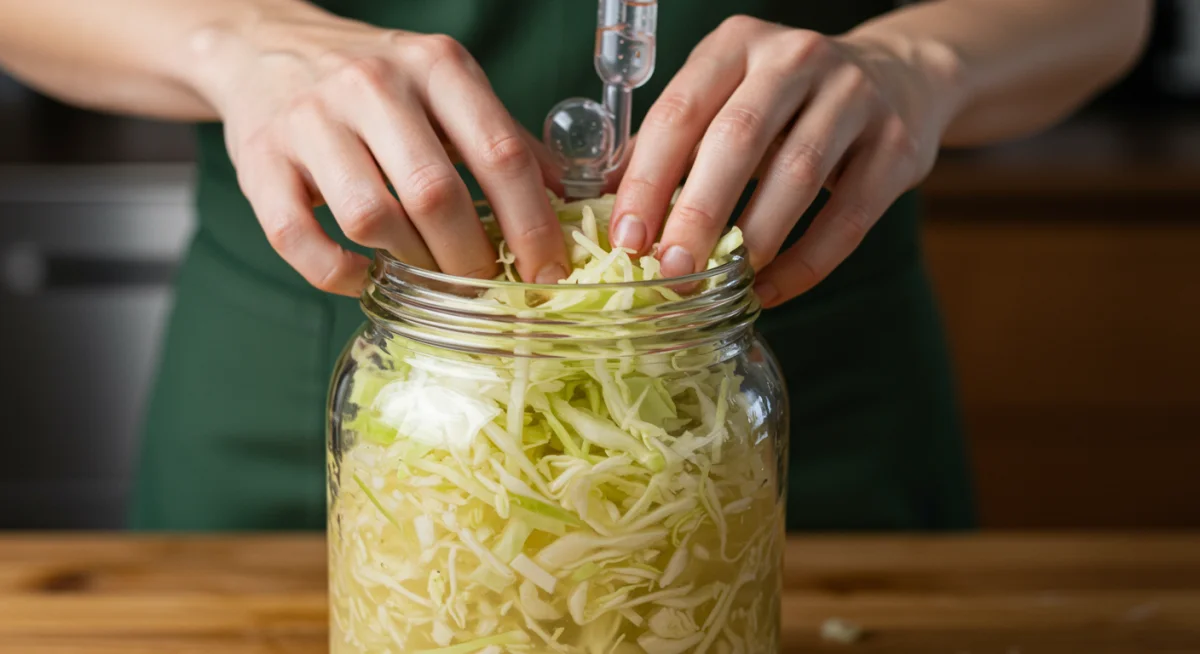
- Ingredients: 1 medium-sized green cabbage (about 3 lbs), 2 tablespoons sea salt (non-iodized). Optional additions: caraway seeds, juniper berries, or shredded carrots for flavor variation.
- Preparation: Remove any damaged outer leaves from the cabbage. Quarter the cabbage and remove the core. Finely shred the cabbage using a mandoline, food processor, or sharp knife. Place the shredded cabbage in a large, sturdy bowl.
- Salting and Bruising: Sprinkle the sea salt over the shredded cabbage. Begin to massage and squeeze the cabbage with your hands (gloves recommended). This process helps to break down the cell walls and release water, creating the brine naturally. Continue massaging for 5-10 minutes until a significant amount of liquid has accumulated at the bottom of the bowl.
- Packing and Fermentation: Transfer the cabbage and its brine into a clean, wide-mouth glass jar. Pack it down very tightly, pressing out any air pockets. Ensure the cabbage is completely submerged under its own liquid. If there isn’t enough liquid, you can add a small amount of salt water (1 tsp salt per cup of water) to cover the cabbage. Place a smaller jar or a fermentation weight on top to keep the cabbage submerged. Cover the jar loosely with a lid or a cloth secured with a rubber band to allow air exchange. Ferment at cool room temperature (60-70°F or 15-21°C) for 2-4 weeks, or even longer for a tangier flavor. Check periodically to ensure the cabbage remains submerged and remove any mold (though rare with proper technique). Once it reaches your desired taste, move it to the refrigerator.
This simple sauerkraut recipe yields a powerful probiotic food that can be enjoyed with virtually any meal. Its tangy flavor complements sausages, sandwiches, and salads, offering a daily dose of beneficial bacteria to support your gut health and improve overall digestion. Incorporating homemade sauerkraut into your diet is a straightforward way to contribute to a more diverse and resilient gut microbiome.
Kefir: The Probiotic Dairy Drink
Kefir, a fermented milk drink, is often described as a thinner, tangier version of yogurt, but with a far more diverse and potent probiotic profile. Originating from the Caucasus Mountains, kefir is traditionally made by fermenting milk with kefir grains—a symbiotic culture of bacteria and yeasts (SCOBY). These grains resemble small cauliflower florets and are responsible for the unique fermentation process that yields a creamy, slightly effervescent, and incredibly probiotic-rich beverage. While dairy kefir is most common, water kefir offers a dairy-free alternative with similar benefits.
The microbial diversity in kefir is exceptional, often containing dozens of different strains of bacteria and yeasts, many of which are not found in yogurt. This broad spectrum of microorganisms makes kefir particularly effective in promoting gut health, aiding digestion, and boosting the immune system. For those with lactose intolerance, the fermentation process in dairy kefir breaks down much of the lactose, making it often more digestible than regular milk.
Homemade Dairy Kefir Recipe
Making dairy kefir at home is remarkably simple and cost-effective once you obtain kefir grains. The grains are reusable indefinitely, making kefir a sustainable source of probiotics.
- Ingredients: 1-2 tablespoons active kefir grains, 1-quart fresh whole milk (cow, goat, or sheep milk work best). Avoid ultra-pasteurized milk initially.
- Preparation: Place the kefir grains in a clean glass jar. Pour the milk over the grains, ensuring the grains are fully submerged. Do not fill the jar to the very top; leave some headspace.
- Fermentation: Cover the jar loosely with a lid or a breathable cloth secured with a rubber band. This allows gases to escape while keeping contaminants out. Let the jar sit at room temperature (68-72°F or 20-22°C) for 12-48 hours. The fermentation time depends on the temperature and your desired tanginess. Warmer temperatures will ferment faster.
- Straining: Once the kefir has thickened and smells pleasantly tangy (you might see small curds and whey separating), gently stir it. Strain the kefir through a non-metal fine-mesh sieve into another clean jar or bottle. The grains will remain in the sieve.
- Storage and Re-fermentation: Store the finished kefir in the refrigerator. Immediately place the strained kefir grains back into a clean jar and add fresh milk to start a new batch. If you need a break, you can store the grains in fresh milk in the refrigerator for up to a week, or longer in a larger amount of milk.
Homemade Water Kefir Recipe (Dairy-Free Alternative)
For those who prefer a dairy-free option, water kefir grains can ferment sugar water, creating a light, fizzy, and probiotic-rich beverage.

- Ingredients: 1/4 cup water kefir grains, 1/4 cup sugar (cane sugar works well), 1/2 gallon filtered water, optional: a few dried fruits or a slice of lemon for minerals.
- Preparation: Dissolve the sugar in a small amount of warm water, then add it to the filtered water in a clean glass jar. Ensure the water is at room temperature before adding grains. Add the water kefir grains and optional dried fruits/lemon.
- Fermentation: Cover the jar loosely and let it ferment at room temperature for 24-48 hours. The water kefir will become less sweet and slightly fizzy.
- Straining and Flavoring: Strain the water kefir, separating the grains. The grains can be reused immediately. The fermented water kefir can be consumed as is or flavored with fruit juice, ginger, or herbs for a second fermentation in a sealed bottle for extra fizz.
Both dairy and water kefir provide a powerful and diverse array of probiotics, making them excellent choices for boosting gut microbiome diversity. Regular consumption can lead to improved digestion, enhanced immunity, and a general sense of well-being, effectively contributing to your health goals for 2025.
Integrating Fermented Foods into Your Diet for 2025
Incorporating fermented foods into your daily routine doesn’t have to be complicated. The key is consistency and variety. By regularly consuming small amounts of different fermented foods, you provide your gut microbiome with a continuous supply of diverse beneficial bacteria. This approach is more effective than sporadic large servings, as it helps to establish and maintain a stable and robust inner ecosystem. Aim for at least one serving of a fermented food daily, gradually increasing as your body adjusts.
Think beyond just eating them plain. Kimchi can liven up a sandwich or a bowl of rice. Sauerkraut is a classic accompaniment to savory dishes and can be added to salads. Kefir can be a base for smoothies, a dressing for fruit, or a refreshing drink on its own. Experimentation is encouraged to find what works best for your palate and lifestyle, making the integration both enjoyable and sustainable.
Practical Tips for Daily Consumption
Making fermented foods a regular part of your diet can be easier than you think. Start small and gradually increase your intake to allow your digestive system to adapt. Listen to your body and adjust as needed.
- Start with Small Portions: Begin with a tablespoon or two of kimchi or sauerkraut, or a quarter cup of kefir. Gradually increase the amount over a few weeks.
- Vary Your Ferments: Don’t stick to just one. Rotate between kimchi, sauerkraut, kefir, and other fermented options like kombucha or miso to introduce a wider range of microbial strains.
- Incorporate into Meals: Add fermented vegetables as a side dish, topping for tacos, or mixed into salads. Use kefir in smoothies, overnight oats, or as a base for creamy dressings.
- Consistency is Key: Regular, even small, intake is more beneficial than occasional large servings. Make it a habit, perhaps with a meal you consistently eat.
Beyond these specific recipes, remember that fermented foods are living entities. Proper storage in the refrigerator slows down fermentation, preserving their probiotic content. Avoid heating fermented foods to high temperatures, as this can kill the beneficial bacteria. Adding them at the end of cooking or consuming them raw is best. By making these small, consistent changes, you can significantly boost your gut microbiome diversity and reap the extensive health benefits that fermented foods offer, setting a strong foundation for your health in 2025.
Addressing Common Concerns and Troubleshooting
Embarking on your fermented foods journey can sometimes come with questions or minor hurdles. It’s important to remember that fermentation is a natural process, and slight variations are normal. Understanding common concerns can help you troubleshoot and ensure your homemade ferments are safe and successful, maximizing their potential to boost your gut microbiome diversity.
One frequent query revolves around the appearance of mold. While rare with proper technique, mold can sometimes appear on the surface of fermented vegetables if they are exposed to air. Generally, if you see fuzzy, colored mold (black, green, pink), it’s best to discard the batch. However, a thin white film, often called kahm yeast, is usually harmless and can be scraped off. Ensuring your vegetables remain submerged under the brine is crucial to prevent mold growth.
Troubleshooting Tips for Successful Fermentation
Even experienced fermenters encounter issues occasionally. Knowing how to address them can save a batch and build your confidence.
- Lack of Fermentation Activity: If your ferment isn’t bubbling or becoming tangy, the temperature might be too cold, or there might not be enough salt (for vegetables) or active grains (for kefir). Move to a warmer spot, or ensure your grains are active.
- Too Salty/Sour: Adjust salt levels in future batches for vegetables. For kefir, shorten fermentation time or add more milk if it’s too sour.
- Off-Smells: A pleasant, slightly sour or yeasty smell is normal. Foul, putrid, or alcoholic smells can indicate spoilage. Trust your nose; if it smells bad, it likely is.
- Mushy Vegetables: This can occur if the vegetables were not fresh, too much salt was used, or the fermentation temperature was too high. Using fresh, crisp vegetables and maintaining optimal temperatures helps.
Another common concern is the initial digestive discomfort some people experience when first introducing fermented foods. This is often a sign that your gut microbiome is adjusting to the influx of new bacteria. Start with very small portions and gradually increase them. If discomfort persists, consult with a healthcare professional. Remember, the goal is to gently encourage a more diverse and resilient gut, not to shock it. With these tips, you’re well-equipped to navigate the exciting world of homemade fermented foods and enjoy a healthier gut in 2025.
| Key Fermented Food | Primary Benefit for Gut Health |
|---|---|
| Kimchi | Introduces diverse lactic acid bacteria, supports immunity, and adds fiber. |
| Sauerkraut | Rich in Lactobacillus strains, aids digestion, and enhances nutrient absorption. |
| Dairy Kefir | Highly diverse SCOBY, improves lactose digestion, and boosts immune response. |
| Water Kefir | Dairy-free probiotic source, supports hydration, and introduces varied bacterial strains. |
Frequently Asked Questions About Fermented Foods
Fermented foods are those transformed by microorganisms like bacteria and yeasts, which break down carbohydrates. This process creates beneficial compounds, including probiotics, that enhance gut health, aid digestion, boost immunity, and increase nutrient absorption, making them excellent for overall well-being.
Start with small portions, such as 1-2 tablespoons of fermented vegetables or 1/4 cup of kefir daily. Gradually increase as your body adjusts. Consistency is more important than quantity; regular intake helps maintain a diverse and healthy gut microbiome.
Many individuals can achieve significant gut health benefits and increase microbiome diversity through regular consumption of various fermented foods. While supplements can be useful, whole foods offer a broader spectrum of beneficial microbes and nutrients. Consult a healthcare provider for personalized advice.
Yes, homemade fermentation is generally safe with proper hygiene. Ensure all equipment is clean and ingredients are fresh. Watch out for fuzzy, colored mold (discard if present), but a thin white film (kahm yeast) is usually harmless. Keep vegetables submerged to prevent spoilage.
Dairy kefir is made with milk, while water kefir ferments sugar water, offering a dairy-free option. Both provide diverse probiotics. Dairy kefir often has more strains and nutrients, but water kefir is excellent for those avoiding dairy or seeking a lighter drink. The ‘better’ choice depends on dietary needs and preferences.
Conclusion
Embracing fermented foods in 2025 is more than a culinary trend; it’s a strategic investment in your health, particularly for nurturing a vibrant and diverse gut microbiome. The simple homemade recipes for kimchi, sauerkraut, and kefir outlined in this guide provide accessible pathways to integrate these probiotic powerhouses into your daily diet. By consistently incorporating these delicious and beneficial foods, you can actively contribute to boosting your gut microbiome diversity by 25% or more, fostering improved digestion, enhanced immunity, and an overall sense of well-being. The journey to better health often begins in the gut, and fermented foods offer a natural, effective, and enjoyable way to cultivate that vital inner ecosystem.
